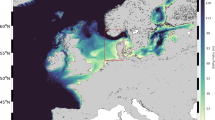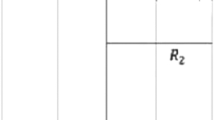Summary
The wave drag, caused by horizontal components of normal air pressures, had been evaluated by three methods: wind tunnel tests on rigid models, observations of wave growth at sea, and theories of J. W. Miles and T. Brooke Benjamin. It has been found that neither the magnitude nor the functional form of the pressure drag is correctly predicted by the form of the theory specifically developed for application to rigid models. On the other hand, the form of the theory developed for mobile waves gives results in good agreement with wind tunnel model data at corresponding values of wave steepness. Model tests and theory agree in that the pressure drag does not depend on the Reynolds Number. In the absence of experimental data on pressures acting on water waves, the limits, within which the pressure drag must be confined, are defined by considering the observed rate of wave development at sea, and the total and frictional drag of water surface. Model tests, as well as the theory, give pressure drag estimates which lie within the foregoing limits. Miles' form of the pressure drag coefficient,β *, in terms of the friction velocity,u *, leads to a particularly simple expression for the ratio of the pressure drag to total drag. Thus, rational prediction of the wave growth in wind is connected with the ability to predict the total drag of the sea surface.
Zusammenfassung
Der durch die horizontalen Komponenten normalen Winddrucks erzeugte Wellenwiderstand ist auf drei verschiedene Methoden ausgewertet worden: durch Windkanaltests an starren Modellen, Beobachtungen der Wellenzunahme auf See und mit Hilfe der Theorien von J. W. Miles und T. Brooke Benjamin. Es stellte sich heraus, daß weder die Größenordnung noch die funktionelle Form des Druckwiderstandes genau von der theoretischen Form wiedergegeben wird, die speziell für starre Modelle entwickelt worden ist. Andererseits ergibt die theoretische Form für wandernde Wellen Daten, die bei entsprechenden Werten der Wellensteilheit gut mit den Ergebnissen der Windkanalmodelle übereinstimmen. Modelltests und Theorie stimmen darin überein, daß der Druckwiderstand nicht von der Reynolds-Zahl abhängt. Da experimentelle Daten über den Druck, der auf Wasserwellen ausgeübt wird, fehlen, werden die Grenzen, in denen sich der Druckwiderstand bewogen muß, unter Berücksichtigung der beobachteten Wellenzuwachsrate auf See und des Gesamt- und Reibungswiderstands bestimmt. Modelltests und Theorie ergeben Druckwiderstandsschätzungen, die in den oben erwähnten Grenzen liegen. Miles Druckwiderstandskoeffizientβ * bei einer Schubspannungsgeschwindigkeitβ * führt zu einer besonders einfachen Darstellung des Verhältnisses von Druckwiderstand zu Gesamtwiderstand. So besteht ein Zusammenhang zwischen stichhaltiger Vorausberechnung der Wellenzunahme bei Wind und der Möglichkeit, den Gesamtwiderstand der Meeresoberfläche zu berechnen.
Résumé
La résistance à l'avancement des vagues due aux composantes horizontales de pressions d'air normales a été calculée suivant trois méthodes: par essais en soufflerie sur modèles rigides, par observations à la mer de la croissance des vagues et suivant la théorie de J. W. Miles et T. Brooke Benjamin. On a trouvé que ni la valeur ni la forme de l'expression de la résistance due à la pression ne sont données correctement par la théorie spécifiquement adaptée aux modèles rigides. D'autre part la théorie appliquée aux vagues en mouvement donne des résultats qui concordent bien avec ceux obtenus en soufflerie pour des valeurs correspondantes de la cambrure des vagues. Les essais sur modèles et la théorie sont d'accord sur le fait que la résistance due à la pression ne dépend pas du Nombre de Reynolds. En l'absence de données expérimentales sur l'action des pressions sur les vagues, les limites à l'intérieur desquelles doit être comprise la résistance de pression sont définies en considérant la vitesse de formation des vagues observée à la mer, la résistance totale et la résistance de frottement sur la surface de l'eau. Les essais sur modèles, comme la théorie, donnent des estimations de la résistance de pression qui restent dans les limites mentionnées ci-dessus.
La forme donnée par Miles au coefficientβ * de cette résistance en fonction de la vitesse de frictionu *, permet d'obtenir une expression particulièrement simple du rapport de la résistance de la pression à la résistance totale. De cette façon la prévision rationnelle de la croissance des vagues dans le vent se trouve rattachée à la possibilité de prévoir la résistance totale de la surface de la mer.
Similar content being viewed by others
References
Brooke Benjamin, T. 1959: Shearing flow over wavy boundary. J. Fluid Mech.6, P. 2, 161.
Conte, S. D. and J. W. Miles, 1959: On the numerical integration of the Orr-Sommerfeld equation. J. Soc. Indust. Appl. Math.7, 361.
Dorn, W. G. van, 1953: Wind stress on an artificial pond. J. Mar. Res.12, 249.
Jeffreys, H., 1925: On the formation of water waves by wind. Proc. Roy. Soc. A,107, 188.
Korvin-Kroukovsky, B. V., 1961: Theory of seakeeping. Soc. Naval Architects and Mar. Engrs., New York.
Korvin-Kroukovsky, B. V., 1965: Balance of energies in the development of sea waves, semi-empirical evaluation. Dt. Hydrogr. Z.18, 145.
Lamb, H., 1945: Hydrodynamics. New York.
Longuet-Higgins, M. S., D. E. Cartwright, and N. D. Smith, 1963: Observations of the directional spectrum of sea waves using the motions of a floating buoy. Ocean Wave Spectra. 111. Englewood Cliffs, N. J.
Miles, J. W., 1957: On the generation of surface waves by shear flows. J. Fluid Mech.3, P. 2, 185.
Miles, J. W., 1959: On the generation of surface waves by shear flows. P. 2. J. Fluid Mech.6, 568.
Motzfeld, H., 1937: Die turbulente Strömung an welligen Wänden. Z. Angew. Math. u. Mech.17, 193.
Munk, W. H., 1955: Wind stress on water: a hypothesis. Quart. J. Roy. Meteorol. Soc.81, 320.
Neumann, G., 1954: Zur Charakteristik des Seeganges. Arch. Meteorol., Geophys. u. Biokl., Ser. A,7, 352.
Phillips, O. M., 1957: On the generation of waves in turbulent wind. J. Fluid Mech.2, P. 5, 417.
Pierson, W. J. Jr., G. Neumann, and R. W. James, 1955: Practical methods for observing and forecasting ocean waves by means of wave spectra and statistics. U.S. Navy Hydrogr. Off., Publ. No. 603.
Schlichting, H., 1958: Grenzschicht-Theorie. Karlsruhe.
Schuleikin, W. W., 1960: Theorie der Meereswellen. Berlin: Akademie Verl.
Stanton, T., D. Marshall, and R. Houghton, 1932: The growth of waves on water due to the action of wind. Proc. Roy. Soc. A,137, 282.
Sverdrup, H. U. and W. H. Munk, 1946: Empirical and theoretical relations between wind, sea and swell. Trans. Amer. Geophys. Un.27, 823.
Thijsse, J. Th., 1952: Growth of windgenerated waves and energie transfer. Gravity Waves. Nat. Bur. of Standards. Circ. 521, 281.
Wilson, B. W., 1960: Note on surface wind stress over water at low and high wind speeds. J. Geophys. Res.65, 3377.
Wilson, B. W., 1965: Numerical prediction of ocean waves in the North Atlantic for December, 1959. Dt. Hydrogr. Z.18, 114. [Also: Nat. Engng. Sci. Co., Washington. Techn. Rep. No. SN-77-2.]
Rights and permissions
About this article
Cite this article
Korvin-Kroukovsky, B.V. Air pressures causing wave development, estimate by theory, model tests, and sea observations. Deutsche Hydrographische Zeitschrift 19, 145–159 (1966). https://doi.org/10.1007/BF02226217
Received:
Published:
Issue Date:
DOI: https://doi.org/10.1007/BF02226217




